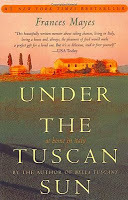Scrumptious Setting = S: Blogging from A to Z
Happy Monday!
It's time for S in the Blogging from A to Z Challenge. Scintillating, isn't it?
Today, keeping with my literary devices theme, I wanted to talk about setting.
Setting
(source)
in literature, the location and time frame in which the action of a narrative takes place
Seems simple, right?
Consider a twelve-year-old girl as a main character. Of course we want to know what she looks like, what her home life is like. Let's say she's a brunette with dark brown eyes and fair skin.
Now, put her in Hollywood in the 80s. How about Germany in 1944? Totally different vibe, but both add details for who our character will be.
 Sometimes the setting becomes another character in the book. In Under the Tuscan Sun, Italy is a vital component to the story. The book's description (from Amazon):
Sometimes the setting becomes another character in the book. In Under the Tuscan Sun, Italy is a vital component to the story. The book's description (from Amazon):
Frances Mayes—widely published poet, gourmet cook, and travel writer—opens the door to a wondrous new world when she buys and restores an abandoned villa in the spectacular Tuscan countryside. In evocative language, she brings the reader along as she discovers the beauty and simplicity of life in Italy. Mayes also creates dozens of delicious seasonal recipes from her traditional kitchen and simple garden, all of which she includes in the book. Doing for Tuscany what M.F.K. Fisher and Peter Mayle did for Provence, Mayes writes about the tastes and pleasures of a foreign country with gusto and passion.
In a true testament to the setting's importance, the cover doesn't feature a character.
Setting can be an actual place or something completely dreamed up by the author. In Hunger Games, Suzanne Collins created District 12. The poverty-stricken, post-disaster area is a key element to the story of Katniss Everdeen. District 12 and The Capitol are a juxtaposition of poverty and opulence. Then, of course, there was the arena where the games were fought. Vivid setting details added to the complexity of the story.
What's your favorite setting in a novel?
Hope you are loving A to Z this year. Check out some amazing participants here .
Show more Show less
It's time for S in the Blogging from A to Z Challenge. Scintillating, isn't it?
Today, keeping with my literary devices theme, I wanted to talk about setting.
Setting
(source)
in literature, the location and time frame in which the action of a narrative takes place
Seems simple, right?
Consider a twelve-year-old girl as a main character. Of course we want to know what she looks like, what her home life is like. Let's say she's a brunette with dark brown eyes and fair skin.
Now, put her in Hollywood in the 80s. How about Germany in 1944? Totally different vibe, but both add details for who our character will be.
 Sometimes the setting becomes another character in the book. In Under the Tuscan Sun, Italy is a vital component to the story. The book's description (from Amazon):
Sometimes the setting becomes another character in the book. In Under the Tuscan Sun, Italy is a vital component to the story. The book's description (from Amazon):Frances Mayes—widely published poet, gourmet cook, and travel writer—opens the door to a wondrous new world when she buys and restores an abandoned villa in the spectacular Tuscan countryside. In evocative language, she brings the reader along as she discovers the beauty and simplicity of life in Italy. Mayes also creates dozens of delicious seasonal recipes from her traditional kitchen and simple garden, all of which she includes in the book. Doing for Tuscany what M.F.K. Fisher and Peter Mayle did for Provence, Mayes writes about the tastes and pleasures of a foreign country with gusto and passion.
In a true testament to the setting's importance, the cover doesn't feature a character.
Setting can be an actual place or something completely dreamed up by the author. In Hunger Games, Suzanne Collins created District 12. The poverty-stricken, post-disaster area is a key element to the story of Katniss Everdeen. District 12 and The Capitol are a juxtaposition of poverty and opulence. Then, of course, there was the arena where the games were fought. Vivid setting details added to the complexity of the story.
What's your favorite setting in a novel?
Hope you are loving A to Z this year. Check out some amazing participants here .
Show more Show less
Published on April 22, 2013 04:00
No comments have been added yet.



